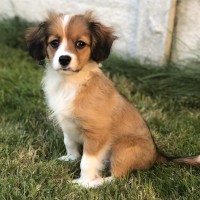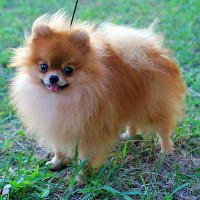 |
Cavapom |
|
He is not recognized by the F.C.I. |
Origin |
Great Britain <> Germany -> U.S.A. | |
Translation |
Francis Vandersteen |
A brief presentation of the Cavapom |
| The Cavapom is a specific cross between the Cavalier King Charles Spaniel and the Spitz Toy / Pomeranian, it would be hard for the Cavapom not to be charming and cute. They are playful and affectionate and can be vigilant like the Spitz Toy / Pomeranian or relaxed and welcoming like the Cavalier. The Cavapom has the potential to be highly trainable, learns quickly and responds to positive reinforcement techniques such as lots of praise and food rewards. Children and the Cavapom mix well, but children under 6 should be supervised with the young dog as they can unintentionally cause injury to such a small dog. They have a moderate energy level that adapts to their owner's lifestyle, but will enjoy a walk and the chance to socialize with other people and dogs, which is good for them. Simply keep them on a leash in an unsecured area while they take off after a flying bird, chasing them off into the distance. Some Cavapoms love to play fetch and will chase a ball endlessly. Others prefer the comfort of your lap and will curl up in it, attracting all the attention you can give them. Because they're adorable pets, they're so popular with families. But be sure to choose a reputable breeder who has carried out health tests to ensure that the puppies are free from genetic diseases common to both parent dogs. |
History of the Cavapom |
| Because the Cavapom is a specific new crossbreed dog, there's little history of how it all began. It's easier to go back to the two breeds of dog that were Cavapom's parents. |
A little of the Cavalier King Charles Spaniel |
||
| The Cavalier King Charles Spaniel takes its name from King Charles II and is descended from the King Charles Spaniel. It was in the late 1600s that King Charles Spaniels were crossed with the Pug dog, resulting in a smaller dog with a flatter nose, large protruding eyes and a rounded head. These became the King Charles Spaniel we know today. But an American by the name of Roswell Eldridge was looking for any King Charles dog with a long nose. He had seen Van Dyck paintings of King Charles II and his Spaniels, before the Pug dog had been crossed with them, and wanted to revive the original breed if he could. He offered a cash prize for such a dog at the Crufts Dog Show in London in 1920. A dog called Ann's Son won the Eldridge prize and belonged to a Miss Mostyn Walker, but Eldridge had died the previous month and wasn't there to present the award. American breeders took up his ideas and, thanks to them, the Cavalier we know today is a product of their breeding. This modern breed is the true heir to the Royal Spaniels of King Charles II. It was in the 1940s that the Cavalier King Charles Spaniel was classified as a separate breed. These attractive, affectionate little dogs are cherished by their owners and have passed on some of their characteristics to the Cavapom, just like the delightful Spitz Toy / Pomeranian. | ||
 |
||
| Standard of the Cavalier King Charles Spaniel | ||
A little of the German Toy Spitz / Pomeranian |
||
| The Spitz Toy / Pomeranian originated in the region known as Pomerania, hence its name. This region is now Germany and Poland. The original Spitz Toy / Pomeranian was a much larger dog that worked for sheep farmers. Shepherds had bred this dog from the old Spitz breeds. It was a popular dog, and Marie Antoinette, Emile Zola, Mozart and Queen Victoria were all famous people who cherished this dog. It was in the 1870s that the Kennel Club in England first recognized them as a breed. Queen Victoria started breeding the Spitz Toy / Pomeranian in 1888, and she began breeding them in smaller sizes, which made them even more popular in England. The American Kennel Club first recognized these little royal dogs in 1888. While the Spitz Toy / Pomeranian may have reduced in size, its sense of personal importance has never diminished. The Pomeranian has a variety of talents in its arsenal, including watchdog, agility and tricks, which is why they were perfect for circus performers. | ||
 |
||
| Standard of the German Toy Spitz / Pomeranian |
Appearance of the Cavapom |
| The Cavapom is a small, well-proportioned dog with a slightly rounded skull and full muzzle. The color of the nose depends on the genes it has inherited from its parent dog, and can range from black like the Cavalier to a different coat color. Teeth meet in a scissor bite. Their dark eyes are rounded or almost almond-shaped, and often have dark rims. It's often difficult to see their body shape, especially if they have the Pomeranian's fluffy coat. Like most hybrids, they can differ in features such as ears, which in the Cavapom can be small and erect like the Pomeranian, or long, erect ears that are high and have abundant feathers like the Cavalier. The coat may favor either the thick double coat of the Pomeranian, hard in the outer layer and soft and short in the undercoat. If it's after Cavalier, the coat can be silky, medium-length and feathery on ears, chest, body and legs. The tail can vary in feathering, lying straight and flat on the back, or long and elegantly feathered held lower down. Whichever parent their genetics prefer, the Cavapom is a distinguished little dog with lots of character and personality. |
Temperament of the Cavapom |
| The Cavapom is a proud and lively little dog, affectionate, happy and outgoing. They are eager to please their owners, easy to train and highly intelligent. Although they appear to be confident dogs, they need a firm but gentle hand when training. They respond well to lavish praise and attention, as well as small treats. If you make it clear from the outset that you are the pack leader, they will respect and follow your every move with devotion and loyalty. These dogs are not adapted to kennel life; they are human dogs and want to be with their family all the time. The Cavapom is an ideal dog for apartment living, just be firm if your dog starts barking excessively when people come through the door, teaching them that one bark is enough for your neighbors to appreciate your pet. If you plan to be away during the day, make sure your dog is walking well to tire him out first, so he doesn't become destructive or develop destructive behavior. These dogs still have the instinct to hunt, so keep them on a leash when out walking. If they're well trained and accept you as pack leader, they make a delightful family dog. Teach young children to be careful with the little dog, as rough play can accidentally injure the Cavapom. They mix well with other animals if raised with them, often being very good friends and companions. |
Needs and activities of the Cavapom |
| While play and its natural active behavior will meet most exercise needs, the Cavapom will appreciate a walk that will keep it fit and socialize the dog. They still have an instinct to hunt, so it's advisable to keep them on a leash. Cavapoms love to learn new tricks and will excel at training with plenty of encouragement. They can overheat on hot days, so keep them calm and cool on long, hot summer days. Make sure they have plenty of ventilation and shade options. Although the Cavapom doesn't need a garden, if it has one, it'll love exploring it if you're there too. |
Maintenance of the Cavapom |
| It all depends on the type of coat your Cavapom inherits. If he has a Pomeranian-style coat, he'll need considerable brushing to keep it tidy. The easiest way is to divide or separate the coat and brush forward, working your way from the head to the back. In the end, it will easily fall back into place. If your Cavapom takes after the Cavalier, it will need regular brushing with a firm bristle brush to keep it clean. Use a dry shampoo if necessary and check that feathers are not matted. Regularly clean the inside of the ears and check the eyes for any signs of infection. A final check-up and teeth brushing will keep your Cavapom healthy and in perfect condition. |






 English (United Kingdom)
English (United Kingdom)